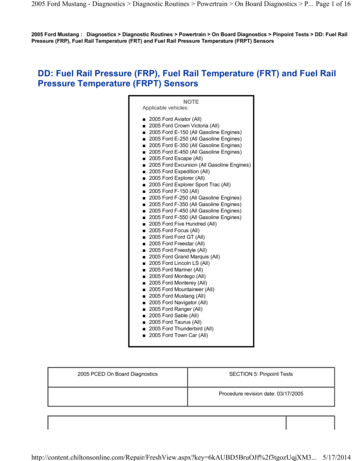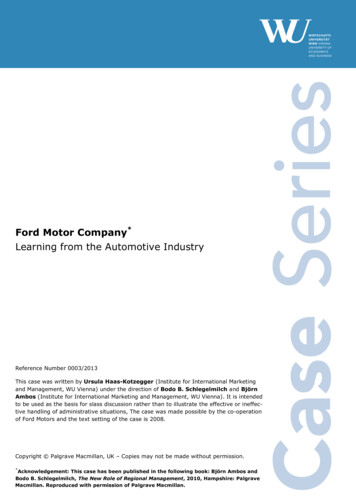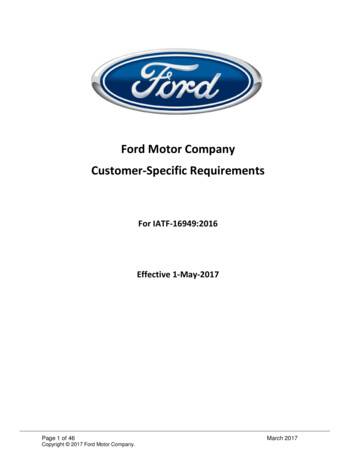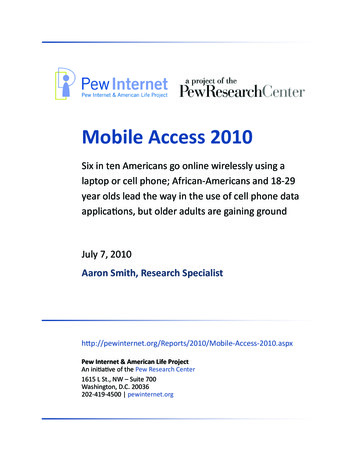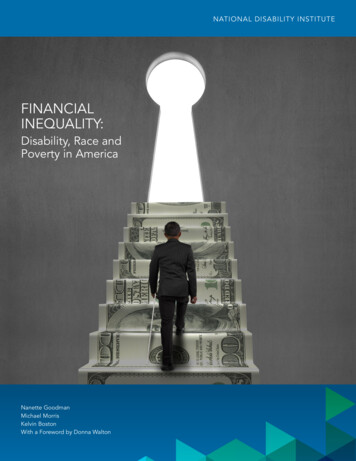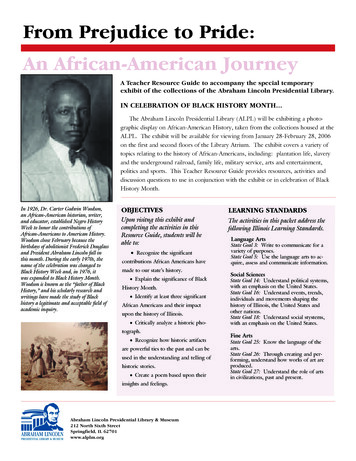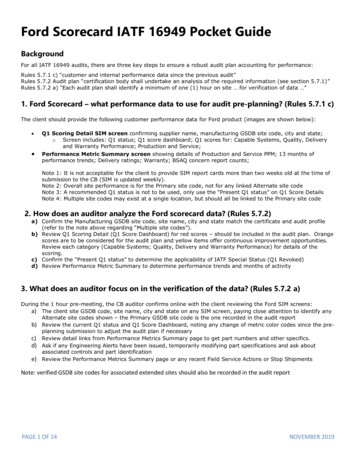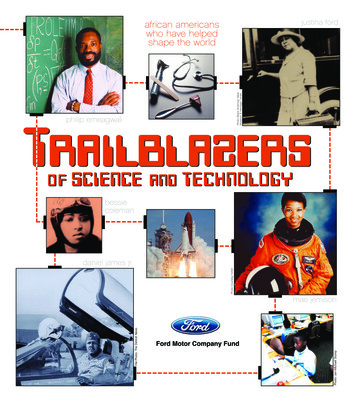
Transcription
Photo Courtesy: NASAPhoto: Black American WestMuseum & Heritage Centerphilip emeagwaliPhoto: Jan-Michael StumpFile Photo: The Detroit Newsafrican americanswho have helpedshape the worldjustina fordbessiecolemandaniel james jr.mae jemison
Photo Courtesy: NASA‘THE AVIATOR ANDTHE EXPLORER’A welcome from Christy ColemanFile Photo: The Detroit News2GEN. DANIEL JAMES JR.INTROThe Charles H. Wright Museum of AfricanAmerican History and Ford Motor Companywelcome you to the 2003 Ford Freedom Award.Together, we have designed a program that paystribute to the lives and legacies of African Americanswho have made tremendous contributions whilefacing often-overwhelming obstacles and challenges.The Ford Freedom Award pays tribute to those leaders who helped shape America.Christy Coleman isSince 1999, the Ford Freedom Award programPresident and CEOhascombined prominent African American historicalof the Charles H.Wright Museum ofreferences with contemporary relevance. The 2003African AmericanFord Freedom Award title is “The Aviator and theHistory.Explorer.” This year’s programhonors the late four-star General Daniel “Chappie” James Jr. as the FordFreedom Award recipient. General James’ achievements are respectedaround the world. He was one of the great Tuskegee Airmen pilots,and as a fighter pilot in Korea and Vietnam he flew nearly 180combat missions. He was the first African American four-star general inthe history of the U.S. military.Former NASA astronaut Dr. Mae C. Jemison is the year’s Ford FreedomScholar. Dr. Jemison is an accomplished contemporary in the fields ofaviation and science. In 1987 Dr. Jemison became the fifth AfricanAmerican astronaut and the first African American woman astronaut inNASA history. Dr. Jemison will share her perspectives on the challenges,opportunities and accomplishments of African Americans in aviationand science.The program also recognizes Bessie Coleman, the first African Americanfemale international pilot, who was installed in the Museum’s FordFreedom Rotunda’s “Ring of Genealogy” when it opened in 1997.DUCTIONDR. MAE JEMISON2003 FORD FREEDOMAWARD HONOREESScience andLeadershipMore minorities are entering science fields todaythan ever before. Yet businesses, government anduniversities would like to attract even more. As aclass, discuss the advantages of careers in scienceand technology. Then find a science or technologybusiness in the ads or stories of today’s newspaper.Alone or in teams draw up a five-point messagefor a school assembly to attract African Americanstudents and others to a career with this business.Explain the importance of each point to the class.Point 1Point 2ABOUT THE MUSEUMThe late Dr. Charles H. Wright founded the Museum of AfricanAmerican History in 1965. Dr. Wright’s vision was to create an institutiondedicated to the African American experience. In addition to the “Ring ofGenealogy,” the Museum houses more than 20,000 artifacts and piecesof archival material. The Museum also has a research library, a 317-seattheater and the Museum Store, which sells authentic African and AfricanAmerican art, books and other merchandise.The Museum also produces the annual “African World Festival” thatshowcases the various cultures of the African Diaspora. Each year, thefestival held in Hart Plaza on the Detroit riverfront attracts more thanone million people from around the world.Come visit the Museum and become a member of the largest museum of its kind in the world. As we continue to educate and communicate the rich history of African Americans,we’re fortunate to have this esteemed Museum right here in Michigan.Point 3Point 4Point 5
3PIONEER WITH THE TUSKEGEE AIRMENBy Kathy DahlstromInstead of 10 Commandments, General Daniel“Chappie” James Jr. had 11. He added “ThouShalt Not Quit” to the list.His determination helped him rise from pilotwith little hope of seeing combat to the nation’sfirst black four-star general.“I’ve fought in three wars and three morewouldn’t be too many to defend my country,”the highly decorated Air Force officer said whenhe received his fourth star as a general. “I loveAmerica and as she has weaknesses or ills, I’llhold her hand.”Daniel “Chappie” James is the 2003 winner ofthe Ford Freedom Award for past achievement inthe field of aviation and technology.From childhood, he dreamed of flying.He grew up in Florida watching planes fromPensacola Naval Air Station fly by. At that time,African Americans served in the military but werenot allowed to be military pilots.Unhappy with Pensacola’s black schools, hismother started her own for children who livedin the neighborhood.James—who got his nickname from his bigbrother—graduated from high school during theGreat Depression. All his large family chipped into help him attend Tuskegee Institute (nowTuskegee University) in Alabama.He became a pilot and flight instructor ina program based at Tuskegee Army Airfielddesigned to train America’s first black militarypilots. He then joined the group, known as theTuskegee Airmen.These brave black pilots flew planes alongsideAmerican bombers during World War II. TheyABOUT THISSECTIONTo celebrate this year’s FordFreedom honorees and BlackHistory Month, Ford MotorCompany, The Detroit News andthe Charles H. Wright Museumof African American History present the educational supplement“Trailblazers of Science andTechnology.” This special sectionhonors African Americans knownfor their achievements in scienceand technology. These are storiesto inspire all Americans—stories that enrich our history.protected them from German attackers and shotdown enemy warplanes, including the world’sfirst combat jet built by the Germans. They evensank a destroyer.The pilots were called the “Black RedtailAngels” because of the red paint on their planes’tails and their reputation for not losing bombersover Europe.During World War II, James received fightertraining at what is now Selfridge Air NationalGuard Base near Mt. Clemens, Michigan.Opposed to policies that separated black andwhite soldiers, he and 100 other officers werearrested in 1945 for demanding service at awhites-only club at an Indiana base. James latercalled this the first civil rights sit-in.After President Harry Truman ordered the military integrated in 1948, James’ career took off.He gained a reputation as a fierce combat pilot,flying 101 combat missions in the Korean War and78 over North Vietnam during the Vietnam War.The F-46 jet fighter he flew in the Bolo MiGsweep that destroyed seven Communist MiG-21sin Vietnam now sits on the Tuskegee Universitycampus.As commanding officer of the U.S. Air Forcebase in Libya, he reportedly turned away dictatorMuammar Khadafy at the front gate.In 1975 the commander became the first blackfour-star general. When he retired in 1978 forhealth reasons, he was commander-in-chief ofNorth American Aerospace Defense Command(NORAD), which defends U.S. and Canadian airspace. He died shortly after retirement of a heartattack.GENERALDANIEL ‘CHAPPIE’JAMES JR.(1920-1978)PREVIOUSFORD FREEDOMAWARD WINNERSFord Motor Company in cooperation with theCharles H. Wright Museum of African AmericanHistory in Detroit has honored:1999 - Former Detroit Mayor COLEMAN YOUNGand ANDREW YOUNG, former Atlantamayor and U.S. ambassador to theUnited Nations2000 - Actor/singer/dancersSAMMY DAVIS JR.and GREGORY HINESFile Photo: The Detroit News2001 - Writers LANGSTON HUGHESand SONIA SANCHEZ2002 - Baseball greatsJACKIE ROBINSONand REGGIE JACKSON
4EXPLORER OF WORLDSAS AN ASTRONAUTPhoto: NASA via ReutersBy Kathy DahlstromMAE C. JEMISON(1956- )SCIENCEScience is all around us, so Mae C. Jemison thinks everyoneneeds to know more about it.“At the heart of science are the words ‘I think,’ ‘I wonder’and ‘I understand,’“ said the former astronaut, who is botha chemical engineer and a physician.“To me science is the search for understanding. Withunderstanding we can seek solutions to our problems.”Jemison, the 2003 Ford Freedom Award Scholar, is bestknown as the first woman of color to go into space. Sheconducted science experiments on weightlessness andmotion sickness aboard the space shuttle Endeavor in 1992.Today she works to improve conditions here on Earth.Her two companies—The Jemison Group and BioSentient—integrate science and technology in different ways to makelife better for people around the world. Their projects rangefrom solar energy and satellite communications to monitoringthe body’s vital signs for stress.Jemison also started The Earth We Share, an internationalscience camp at which students ages 12 to 16 try to solveglobal problems. At this camp teens wrestle with pressingissues such as what to do with garbage, how many people theEarth can hold and how free trade will affect the environment.Jemison believes it’s important to understand how thingswork in order to make good decisions. “Technology is just atool,” she said, pointing out that chemicals can be combined toeither propel bullets or create the beauty of a fireworks display.“What technology develops depends on the people we are,the society we are. It really is our choice.”At 46, Jemison is a popular speaker who uses her own lifeas an example of how important choices can be. In her autobiography Find Where the Wind Goes, she admits she wasafraid of heights as a child. But she controlled her fear to getwhere she wanted to go—first to dance class, later to space.Now a Houston, Texas, resident, Jemison encourages youthnot to let other people limit them. Instead, she says, theyshould follow their dreams.“You get to be part of this world. You don’t have to ask permission,” Jemison tells student groups. “You’re already here.”Born in Decatur, Alabama, and raised in Chicago, thefuture astronaut was fascinated by the sky from an early age.Jemison conducted experiments aboardthe space shuttle Endeavor in 1992.She remembers lying on the ground as a child and staring up atthe stars “with all my intensity and wanting to be there.”The fact that it would be hard for a black girl of the 1950s and‘60s to make it into space didn’t faze her. “I could see myself inspace, even though others couldn’t,” she recalled.She entered Stanford University at just 16 on a scholarship, graduating with degrees in chemical engineering and African and AfroAmerican Studies. She earned her doctorate in medicine at CornellUniversity Medical College.Before joining the National Aeronautics and Space Administration(NASA), she was a doctor in Los Angeles and a Peace Corps medical officer in West Africa.A Detroit public school specializing in science and technology—Mae C. Jemison Academy—is named for her.Among other honors, Jemison was chosen one of People magazine’s “World’s 50 Most Beautiful People” and was targeted as apotential candidate to be the first woman president by the WhiteHouse Project of the non-profit Women’s Leadership Fund.Leadership is important to her, and youth should “demand adultsdo their job now—lead the world.”“Ideas are really wonderful, but nothing will happen until we riskputting them in action,” she said.
JEMISON ACADEMYPhoto: Jan-Michael Stumpscience with a human faceStudents at Jemison Academyuse technology in many classesand do a wide range of experiments.Photo: Smithsonian National Air & Space MuseumBESSIECOLEMANFLIGHTPIONEER(1893-1926)Most kids never get to meet the people forwhom their schools are named. But Mae C.Jemison is a living inspiration to students atthe Detroit school that bears her name.The entire school traveled to LawrenceTechnological University in Southfield this year tohear the astronaut speak. And fifth-graders metwith her at the Detroit Public Library in June.“They all know who she is,” said PrincipalSheila Jenkins, who presented Jemison witha school jacket and student art.The connection between Mae C. JemisonAcademy and its namesake is especially important because of the mission of the school.Students from all over Detroit come to theAcademy for education with an extra emphasison science and technology.In 2001 this school of choice won a stateGolden Apple award for improvement inscience scores on the state MEAP tests.Bessie Coleman faced discrimination on twocounts when she tried to get her pilot’s license inthe early 1900s: She was a woman, and she wasan African American.No flight school would accept her. But Colemanwould not be stopped in her dream of flying. Shesaved up the money she earned as a manicurist,learned to speak French and went to Europe,where she learned to fly from French aviators.Her perseverance paid off. In 1921, she becamethe first African American in the world to earn aninternational pilot’s license.Hard work was a way of life for Bessie Coleman.Born in Texas, she picked cotton and did laundry tohelp her family while growing up. Later, after shemoved to Chicago, she trained in a beauty schooland got a job as a manicurist.It wasn’t a path that would seem to lead to acareer in aviation. But she got the flying bug afterreading about the exploits of aviators, and founda way to get to France for training.When she returned to the United States,Coleman flew in air shows throughout the country,hoping to raise enough money to open a flyingschool for African Americans. But she died beforethat dream could be realized, thrown from thecockpit of her plane during a test flight inJacksonville, Florida.Her accomplishments were recognized in 1994by the U.S. Postal Service, which issued a stamp inher honor.This year, she is being honored as well as part ofthe Ford Freedom Awards celebration.AVIATIONPhoto: Jan-Michael Stump5“In today’s world, which emphasizescomputers and technology, it’s importantfor students to be exposed,” Jenkins said.“Our world is a technological world.”All 350 elementary students spend timeeach week in the school’s computer lab.Even preschoolers learn the keyboards.“They surprise you with what they’reable to do,” said Leslie Bennett, educationaltechnician. “They don’t have the fearssome adults have. They like computers.”In the science lab, third- through fifthgraders do a wide range of experiments.This year they are studying the animalkingdom, how to use the metric systemand the growth of seeds and plants.“Science is all around us,” said scienceteacher Angele Maynard, who chose theDetroit school system because of its excellent elementary science program.“Everywhere we go we bump into it.It’s the real world in our classroom.”Science andLeadershipMae Jemison and Bessie Colemanare trailblazers in science andaviation. They are also trailblazersas women and African Americans.More and more women are choosing scientific careers or careersinvolving aviation or space. Intoday’s newspaper, find a storyinvolving science or aviation. Readthe story. Then make a list ofjobs connected to the story thatmore women hold today than 20years ago. Make a second list ofjobs connected for which womenare not hired frequently. Write asentence stating what challengeswill need to be overcome formore women to hold thosescience jobs in the future.
PATRICIA COWINGSNASA RESEARCH PSYCHOLOGIST(1942- )Photo Courtesy: NASA6EGUION S.BLUFORD JR.FIRST BLACKASTRONAUT(1942- )On August 30, 1983, Lt. Colonel Guion S.Bluford, aerospace engineer and U.S. astronaut,became the first African American to travel inspace. A Penn State graduate, Bluford is alsoa veteran of the Vietnam War, in which he flew144 combat missions as an Air Force pilot. Hejoined the NASA’s space program in 1979. Hisfirst flight was on the shuttle Challenger. Heflew two other space missions.Photo Courtesy: NASAAResearch psychologist Patricia Cowings works for NASA, helping astronauts adapt to spaceusing biofeedback, self-hypnosis and desensitization.Her work has been especially important helping astronauts prevent “space sickness”—and italso can aid cancer patients dealing with chemotherapy.Cowings has worked for NASA for a long time. She was the first female scientist trainedas an astronaut, but as an alternate she never flew a mission.A professor at UCLA, Cowings concedes, “I was not so good at math as a kid. I learnedto use it as a tool.“But science was always a game,” she said. “You run your experiment and then add up yourpoints to see if you won!”As the director of Psychophysiological Research at Ames Research Center, Cowings knows theworth of aiming high. “I’ve spent my life studying human potential—and stretching my own.”ROSPACEO.S. ‘OZZIE’ WILLIAMSROCKET SCIENTIST(1921- )Photo: U.S. Dept. of EnergyWhen looking at simple tasks, people often say “it doesn’t take a rocket scientist to do that.”But at the NASA space agency, it DOES take a rocket scientist to handle many of the challenges.O.S. “Ozzie” Williams was one of the best among companies assisting NASA.He was in charge of the team at Grumman International that produced the control systemsused in guiding lunar landing modules during NASA’s historic Apollo moon landings.Born in New York and educated at New York University, Williams was the first AfricanAmerican to be hired as an aeronautical engineer by Republic Aviation during World War II.After the war, he went to work for Greer Hydraulics, where he helped develop the first airborneradar beacon, which was used to find crashed aircraft.Ozzie Williams went on to become a vice president of Grumman International, in charge oftrade and industrial relations with emerging African nations. His work included helping Africansharness solar and wind energy.Science andLeadershipNASA requires many kinds ofscientists to plan and run aspace mission. Turn to theHelp Wanted pages in today’snewspaper and pick five jobsfrom different fields of science. For each one, write asentence stating what rolethat field of science couldhave in planning or running aNASA mission in space. Put astar next to the one you thinkwould be most important to amission.
Photo Courtesy: Duke Medical Center7JAMES MCCUNE SMITHTRAILBLAZING DOCTOR(1811-1865)James McCune Smith was the first African American university-trained doctor. Yet because of racistpractices in the United States at the time, he had to travel all the way to Scotland to get an educationin medicine after he graduated from the New York African Free School.While in Scotland, he founded the Glasgow Emancipation Society, and when he returned to his hometown of New York City in 1837, he continued his dedication to the abolition (outlawing) of slavery.In New York, Smith ran a successful medical practice. He treated both white and African Americanpatients, which was highly unusual for his time. He also wrote numerous essays supporting abolitionistcauses and voting rights for women.Photo: Black American WestMuseum & Heritage CenterJUSTINA FORD‘THE LADY DOCTOR’OF COLORADO(1871-1952)Justina Ford not only was the first African American physician inColorado, but she remained the only female African American doctorin the state throughout her 50-year career!After she earned her medical degree in Chicago, she spent a shorttime in the the southern United States before moving to Denver, wherepeople lovingly called her “The Lady Doctor.”Ford was committed to helping economically disadvantaged peopleget medical care. In her practice, she specialized in gynecology, obstetricsand pediatrics, and in her career delivered more than 7,000 babies!After her death, her home became the Black America West Museumand Heritage Center.PATRICIA E. BATHGROUNDBREAKERIN EYE CARE(1949- )Patricia E. Bath is a world-famous ophthalmologist(eye doctor). A co-founder of the American Institutefor the Prevention of Blindness, she invented the LaserphacProbe, a tool that uses lasers to remove cataracts.She was born in Harlem and earned her bachelor’sdegree at Hunter College in New York City. She thenearned her medical degree at Howard University. Aftergraduation she became a widely respected expert ineye care.As a member of the International Women in MedicineHall of Fame, Bath uses her fame and influence to support telemedicine—the use of electronic communicationto give people in remote places medical care.MEDICINEScience andLeadershipPatricia Bath won renownadvancing eye care throughthe use of lasers.Medicine is one of the mostimportant fields of sciencebecause it touches people of allethnic groups. For many years inhistory, few African Americanswere allowed to train to be doctors. Today, however, medicalschools are making great effortto train doctors of all ethnic backgrounds? Why is it important tohave doctors with varied ethnicbackgrounds? Discuss as a classand then pair off and write anewspaper editorial giving yourview. Remember that editorialsneed to contain facts that supportthe opinions stated.
8Next time you search the Internet for information for a school report, thank Philip Emeagwali.Emeagwali was born in southeastern Nigeria.Working with his father, who typically madehim do hundreds of calculations a day,Emeagwali became so good at math that hisfriends called him “Calculus.” He had masteredthe subject by age 14.Emeagwali, who now lives in Baltimore,Maryland, did not have an easy childhood. Hisfamily spent time in a refugee camp, and hehad to drop out of school because his familycould not afford to send all eight children. But hecontinued to study on his own, eventually winning ascholarship to Oregon State University at age 17.After graduating, he kept learning, earning master’sdegrees in civil engineering, marine engineering andmathematics, and a Ph.D. in civil engineering (reallyscientific computing).One of Philip Emeagwali’s greatest achievements washis creation of the Connection Machine, which linked65,000 computers to become the fastest computer onEarth: It can perform 3.1 billion calculations per second!His work on the Connection Machine won him theGordon Bell Prize, the equivalent of the Nobel Prize forcomputer science. It also laid the groundwork for thecreation of search engines such as yahoo.com, and isone of the reasons that Emeagwali is considered one ofthe fathers of the Internet.Working with the supercomputer, he also has designedequations to explain how polluted groundwater flows,how the Earth’s interior moves and causes volcanic eruptions, and even how to forecast global warming patterns.Emeagwali is married to Dale Emeagwali, whose workhas led to greater understanding of cancers of the blood.MARK DEANCOMPUTERSCIENTIST(1957- )Photo: SongProPhoto: IBMCOMPUTERSPHILIP EMEAGWALIA FATHER OFTHE INTERNET(1954- )Photo Courtesy: Philip EmeagwaliMark Dean grew up in Jefferson City, Tennessee, where herecalls a white friend in sixth grade asking if he was really black.Dean said his friend had concluded he was too smart to be black.Dean went on to become a star athlete and straight-A studentat his high school, and a top graduate of the University ofTennessee. He eventually earned master’s and Ph.D. degrees inelectrical engineering, and now is director of advanced systemsdevelopment for IBM Server Group.At IBM, Dean and colleagues developed a number of the computer components that all PCs are based upon. In 1999, as directorof IBM’s research lab in Austin, Texas, he led the team that built agigahertz chip that could do a billion calculations per second.He is now working on the “electronic tablet,” a magazine-sizeddevice that could download any electronic text, as well as be a DVDplayer, radio and wireless telephone and provide access to the Internet.With technology, “if you can talk about it, that means it’s possible,” he said. “A lot of kids growing up today aren’t told that youcan be whatever you want to be.”MARC HANNAHENTREPRENEUR(1956- )You’ve seen the results of Marc Hannah’s work on big movie screens. Soon, you might hold it in yourhand. Hannah was one of the original founders of Silicon Graphics Incorporated (SGI), a company famousfor its innovations in computer graphics.SGI designed the computers used to create the special effects for such movies as Terminator 2, JurassicPark, Aladdin, The Hunt for Red October, Beauty and the Beast and Field of Dreams.Today, Hannah is the chief technology officer of SongPro, which is making multimedia plug-ins that youcan use to listen to music on hand-held videogame players.A Chicago native, Hannah graduated from the Illinois Institute of Technology with a degree in electricalengineering. He received a fellowship from Bell Laboratories to pursue his doctorate at Stanford University,which he completed in 1985.Science andLeadershipTechnology is changing the waywe live, especially computer andinformation technology. Searchthe newspaper for a high-techproduct you or your family usethat you did not use three yearsago. Write a declarative sentencestating what made your familydecide to use this new technology. Then write a sentence predicting the next high-tech productyour family will decide to use,and give a reason.
9BENJAMIN S. CARSON, M.D.NOTED NEUROSURGEON(1951- )As a child waiting for a doctor at DetroitReceiving Hospital, Ben Carson imaginedhearing his own name over the loudspeaker.It sounded so important, he thought, “Oneday they’ll be saying, ‘Dr. Carson, Dr. Carsonto the operating room.’”Today, Carson, 51, is known all over theworld. He is director of pediatric neurosurgery at the famous Johns HopkinsHospital in Baltimore, Maryland, treatingchildren for some of the most complicatedailments.Photo: Johns Hopkins Children’s CenterBy Kathy DahlstromIn 1987, for example, he led a 22-houroperation in SouthAfrica that separatedconjoined twins whowere connected at the head at birth. Whileperforming more than 400 operations ayear—mostly brain and spinal surgeries—Dr. Carson spends many hours speaking tostudents about how he beat the odds tobecome a doctor.Growing up in southwest Detroit, he didso poorly at HigginsElementary School thatclassmates called him“dummy.”His mother Sonya, whowas raising him and hisbrother alone, cut downhis television and made himgive home book reports onhis reading. He went on towin honors at Wilson JuniorHigh and graduated from Southwestern HighSchool, Yale University and the University ofMichigan School of Medicine.Today the father of three teenagers, he haswritten three best-selling books and has set uphis own club to encourage students and familiesto read more.SCIENCEPhoto: Detroit Historical MuseumFile Photo: The Detroit NewsCORNELIUS HENDERSONBUILDER OF BRIDGES(1887/88-1976)Traffic flows easily between Detroit and Windsor because of Cornelius Henderson’sengineering know-how. The University of Michigan graduate helped build both theAmbassador Bridge and Detroit-Windsor tunnel.Born in 1887 or 1888 in Detroit, he moved to Georgia when his father became presidentof Morris Brown College. Henderson graduated from Payne University in Alabama, thenearned a civil engineering degree from the University of Michigan in 1911.Although he had returned to Michigan to escape segregation in the South, he hadtrouble finding work in his field. He eventually obtained a drafting job across the borderin Walkerville, Ontario, with the Canadian Bridge Company. During 47 years with thefirm, Henderson became a structural steel designer. He worked on the landmark DetroitWindsor projects, as well as on many other bridges around the world.He also helped design Detroit Memorial Park, the cemetery where he is now buried.ELIJAH MCCOYA ‘GENUINE’INVENTOR(1843/44-1929)Many people copied Elijah McCoy’s mostfamous invention. But smart buyers insistedon “the real McCoy” instead of cheap imitations. We use that expression today to meansomething that is genuine.Working out of his own machine shops inYpsilanti and then Detroit, McCoy patentedmore than 50 inventions in his career,including a portable ironing board, rubbershoe heels, a lawn sprinkler and tire treads.He is best known, however, for an automatic oil cup that allowed trains to oil moving parts without stopping.The son of runaway slaves, McCoy wasborn in 1843 or 1844 in Ontario, Canada.He grew up taking machines apart andputting them back together.He studied mechanical engineering inScotland, but the only job he could find inthe United States was as a fireman/oilman onthe Michigan Central Railroad. It was therethat he developed the automatic oil cup.&MEDICINE
10LONEY GORDONFIGHTER AGAINST DEADLY DISEASES(1915-1999)REASEARCHBefore two Grand Rapids doctors developed a life-saving vaccine, thousands of children diedeach year of the dreaded disease pertussis, or whooping cough.The hard work of Loney Clinton Gordon made much of the doctors’ success possible.It was Gordon who discovered the bacteria that Drs. Grace Elderling and Pearl Kendrick usedin their whooping cough research. Their efforts earned all three women a place in the MichiganWomen’s Hall of Fame.“There wasn’t any fanfare,” Gordon said later. “We were just working to get these babies tostay alive, which we did.”Born in Arkansas in 1915, Gordon moved to Michigan as a child. She earned a bachelor’sdegree in home economics and chemistry from what is now Michigan State University.Although she wanted to be a hospital dietician, she was told white male chefs wouldn’t wantto take orders from a black woman. Kendrick asked her to join the pertussis study that she andElderling were working on after hours. During the day they studied water and milk quality.After looking at thousands of cultures taken from coughing children, Gordon in 1943 founda pertussis organism strong enough to make people sick. The doctors then worked with thatbacteria to develop a vaccine to head off the disease. They later created the DPT (diphtheria,pertussis, tetanus) shot that is given to children today.In 1944 Gordon took a job at the Michigan Department of Health, and worked there untilretiring in 1978.Photo Courtesy: Marge HetheringtonScience andLeadershipDOROTHY V.MCCLENDONCLEANING UPFOR THE MILITARY(1924- )Dorothy McClendon studies microorganisms, those living things that are too tiny to be seenby the naked eye. She specializes in bacteria and fungi.McClendon coordinated microbial research for the U.S. Army Tank Automotive Command(TACOM) in Warren, Michigan.Her job was to
PIONEER WITH THE TUSKEGEE AIRMEN By Kathy Dahlstrom PREVIOUS FORD FREEDOM AWARD WINNERS Ford Motor Company in cooperation with the Charles H. Wright Museum of African American History in Detroit has honored: To celebrate this year's Ford Freedom honorees and Black History Month, Ford Motor Company, The Detroit News and the Charles H. Wright .
